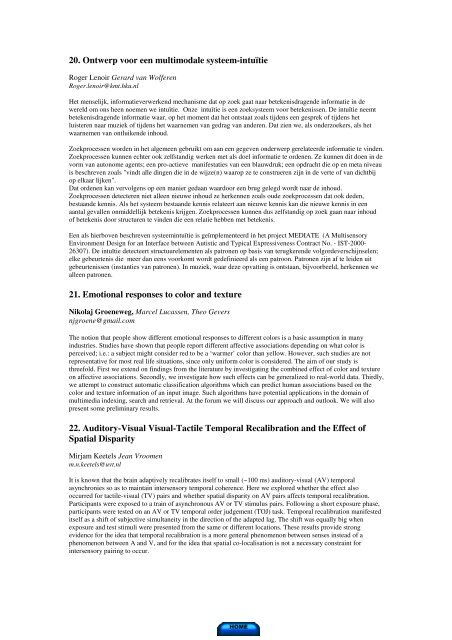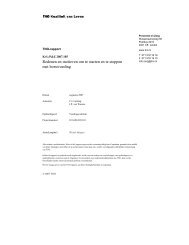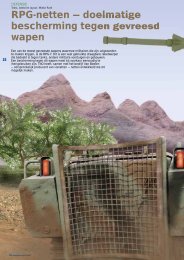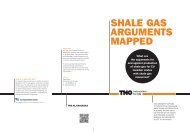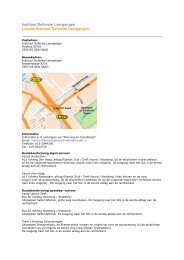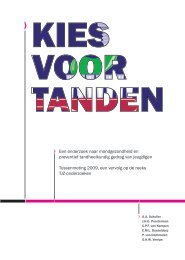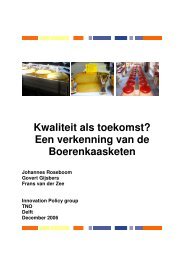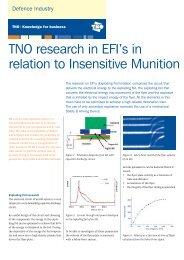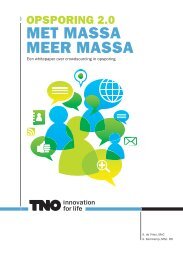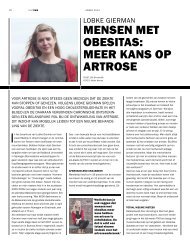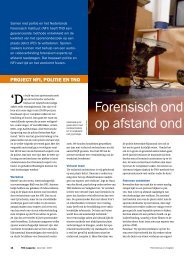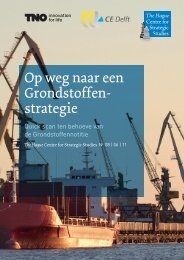Dag van de Perceptie - TNO
Dag van de Perceptie - TNO
Dag van de Perceptie - TNO
Create successful ePaper yourself
Turn your PDF publications into a flip-book with our unique Google optimized e-Paper software.
20. Ontwerp voor een multimodale systeem-intuïtie<br />
Roger Lenoir Gerard <strong>van</strong> Wolferen<br />
Roger.lenoir@kmt.hku.nl<br />
Het menselijk, informatieverwerkend mechanisme dat op zoek gaat naar betekenisdragen<strong>de</strong> informatie in <strong>de</strong><br />
wereld om ons heen noemen we intuïtie. Onze intuïtie is een zoeksysteem voor betekenissen. De intuïtie neemt<br />
betekenisdragen<strong>de</strong> informatie waar, op het moment dat het ontstaat zoals tij<strong>de</strong>ns een gesprek of tij<strong>de</strong>ns het<br />
luisteren naar muziek of tij<strong>de</strong>ns het waarnemen <strong>van</strong> gedrag <strong>van</strong> an<strong>de</strong>ren. Dat zien we, als on<strong>de</strong>rzoekers, als het<br />
waarnemen <strong>van</strong> ontluiken<strong>de</strong> inhoud.<br />
Zoekprocessen wor<strong>de</strong>n in het algemeen gebruikt om aan een gegeven on<strong>de</strong>rwerp gerelateer<strong>de</strong> informatie te vin<strong>de</strong>n.<br />
Zoekprocessen kunnen echter ook zelfstandig werken met als doel informatie te or<strong>de</strong>nen. Ze kunnen dit doen in <strong>de</strong><br />
vorm <strong>van</strong> autonome agents; een pro-actieve manifestaties <strong>van</strong> een blauwdruk; een opdracht die op en meta niveau<br />
is beschreven zoals "vindt alle dingen die in <strong>de</strong> wijze(n) waarop ze te construeren zijn in <strong>de</strong> verte of <strong>van</strong> dichtbij<br />
op elkaar lijken".<br />
Dat or<strong>de</strong>nen kan vervolgens op een manier gedaan waardoor een brug gelegd wordt naar <strong>de</strong> inhoud.<br />
Zoekprocessen <strong>de</strong>tecteren niet alleen nieuwe inhoud ze herkennen zoals ou<strong>de</strong> zoekprocessen dat ook <strong>de</strong><strong>de</strong>n,<br />
bestaan<strong>de</strong> kennis. Als het systeem bestaan<strong>de</strong> kennis relateert aan nieuwe kennis kan die nieuwe kennis in een<br />
aantal gevallen onmid<strong>de</strong>llijk betekenis krijgen. Zoekprocessen kunnen dus zelfstandig op zoek gaan naar inhoud<br />
of betekenis door structuren te vin<strong>de</strong>n die een relatie hebben met betekenis.<br />
Een als hierboven beschreven systeemintuïtie is geïmplementeerd in het project MEDIATE (A Multisensory<br />
Environment Design for an Interface between Autistic and Typical Expressiveness Contract No. - IST-2000-<br />
26307). De intuïtie <strong>de</strong>tecteert structuurelementen als patronen op basis <strong>van</strong> terugkeren<strong>de</strong> volgor<strong>de</strong>verschijnselen;<br />
elke gebeurtenis die meer dan eens voorkomt wordt ge<strong>de</strong>finieerd als een patroon. Patronen zijn af te lei<strong>de</strong>n uit<br />
gebeurtenissen (instanties <strong>van</strong> patronen). In muziek, waar <strong>de</strong>ze opvatting is ontstaan, bijvoorbeeld, herkennen we<br />
alleen patronen.<br />
21. Emotional responses to color and texture<br />
Nikolaj Groeneweg, Marcel Lucassen, Theo Gevers<br />
njgroene@gmail.com<br />
The notion that people show different emotional responses to different colors is a basic assumption in many<br />
industries. Studies have shown that people report different affective associations <strong>de</strong>pending on what color is<br />
perceived; i.e.: a subject might consi<strong>de</strong>r red to be a ‘warmer’ color than yellow. However, such studies are not<br />
representative for most real life situations, since only uniform color is consi<strong>de</strong>red. The aim of our study is<br />
threefold. First we extend on findings from the literature by investigating the combined effect of color and texture<br />
on affective associations. Secondly, we investigate how such effects can be generalized to real-world data. Thirdly,<br />
we attempt to construct automatic classification algorithms which can predict human associations based on the<br />
color and texture information of an input image. Such algorithms have potential applications in the domain of<br />
multimedia in<strong>de</strong>xing, search and retrieval. At the forum we will discuss our approach and outlook. We will also<br />
present some preliminary results.<br />
22. Auditory-Visual Visual-Tactile Temporal Recalibration and the Effect of<br />
Spatial Disparity<br />
Mirjam Keetels Jean Vroomen<br />
m.n.keetels@uvt.nl<br />
It is known that the brain adaptively recalibrates itself to small (~100 ms) auditory-visual (AV) temporal<br />
asynchronies so as to maintain intersensory temporal coherence. Here we explored whether the effect also<br />
occurred for tactile-visual (TV) pairs and whether spatial disparity on AV pairs affects temporal recalibration.<br />
Participants were exposed to a train of asynchronous AV or TV stimulus pairs. Following a short exposure phase,<br />
participants were tested on an AV or TV temporal or<strong>de</strong>r judgement (TOJ) task. Temporal recalibration manifested<br />
itself as a shift of subjective simultaneity in the direction of the adapted lag. The shift was equally big when<br />
exposure and test stimuli were presented from the same or different locations. These results provi<strong>de</strong> strong<br />
evi<strong>de</strong>nce for the i<strong>de</strong>a that temporal recalibration is a more general phenomenon between senses instead of a<br />
phenomenon between A and V, and for the i<strong>de</strong>a that spatial co-localisation is not a necessary constraint for<br />
intersensory pairing to occur.


